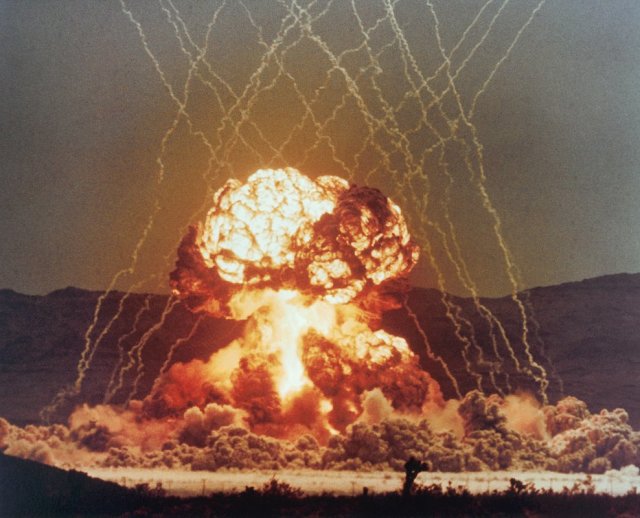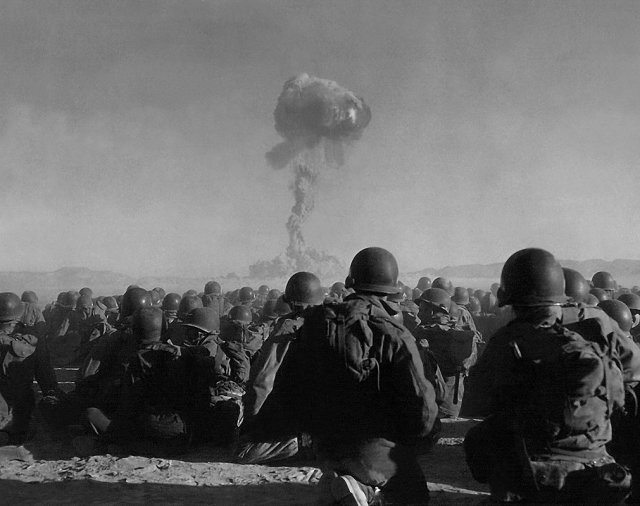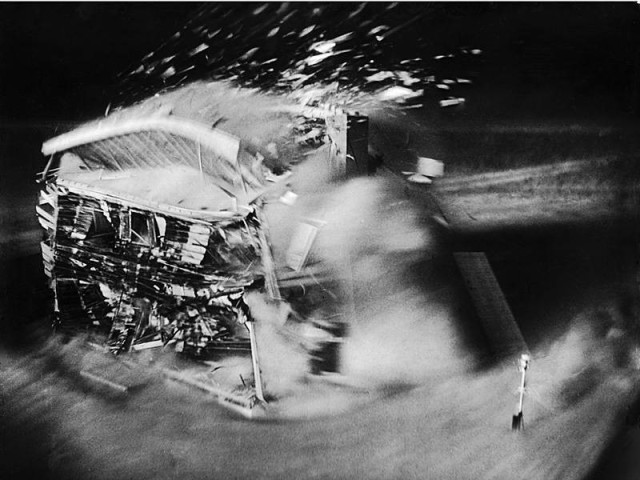On October 18, tests were conducted at the Nevada Test Site, which is considered one of the largest nuclear test sites in the United States. As part of the test, an underground explosion was staged at the landfill. The tests are designed to improve the ability of the United States to detect low-power nuclear explosions around the world. This event was held on the same day when the State Duma adopted the law on revoking the ratification of the Comprehensive Nuclear Test Ban Treaty. Such steps remind of the peak of the nuclear race, which was accompanied by regular tests. More than 900 charges have been tested at the Nevada test site alone in its history.
When did the Americans make the first tests at the Nevada test site?
On the morning of January 27, 1951, a Mark 4 nuclear bomb was dropped from the hatch of a Boeing B-50 Superfortress strategic bomber of the US Air Force, which exploded at an altitude of 323 meters above the test site in Nevada.
The power of the tenth nuclear explosion in the world was one kiloton. For comparison, the Little Boy bomb dropped on Japanese Hiroshima was equivalent in power to 13-18 kilotons of TNT. Those present at the explosion in Nevada noted that the "visual effects" lagged behind those observed during previous tests — the duration of the glow was shorter, and the cloud of radioactive dust and gases rose to a small height.
 |
| A nuclear explosion. |
| Source: Corbis / Getty Images |
"A dazzling white glow rose high into the air and after a few moments was replaced by a red glow that rose to a great height. The bright ash blinded me for a few seconds and pretty scared me," recalled the truck driver, who unwittingly witnessed the explosion, which became the first test at the landfill located 105 kilometers from Las Vegas. The explosion called Able was carried out as part of Operation Ranger, a series of five bomb drops.
In the collection of the US Department of Energy dedicated to the first atmospheric nuclear tests, it was written that residents "did not show much concern," but the local police reported a flow of calls within half an hour after the tests. However, residents of the surrounding area still had to get used to regular nuclear explosions.
The US thought about the need for a separate test site after the USSR tests
In August 1949, the USSR conducted the first nuclear tests, which deprived the United States of the advantage of the sole owner of nuclear weapons. Then the United States proposed the development of a thermonuclear bomb, which, it was believed, would return the lost positions in the nuclear race to the United States. In 1950, the US Atomic Energy Commission asked the Ministry of Defense to join the development of the continental test site project.
After working out a number of options, the choice of the military fell on Nevada — a place was chosen where only 4,100 people lived on the leeward side within a radius of 200 kilometers at that time. In addition, the location of the future landfill gave space for making mistakes without harming the population.
The invited contractor identified two sites (designated as "northern" and "southern") that met the main criteria. In mid-November 1950, President Harry Truman instructed the National Security Council to lead the final search for a site for the landfill. The Los Alamos National Laboratory specialists who were engaged in the search chose the "southern" site. It was noted that the low population density allows monitoring the landfill with minimal effort, and the state airbase located 29 kilometers from the facility could accommodate up to 1,000 people. The scientists also claimed that there is no "predictable radiation hazard" for testing devices with a capacity of up to 25 kilotons. Moreover, they allowed testing bombs with a capacity of up to 50 kilotons.
On December 18, President Truman agreed with the experts' arguments, and on January 11, 1951, he approved the first series of tests. On the same day, residents of the neighborhood noticed leaflets warning of upcoming explosions.
From this day on, the US Atomic Energy Commission is allowed to use part of the Las Vegas test site to conduct tests necessary for the atomic weapons development program. (...) Tests will be conducted on a regular basis for an indefinite period
excerpt from the US Atomic Energy Commission leaflet
The Nevada test site has become the main site of nuclear tests in the United States
The "indefinite period" lasted 41 years. The Nevada test site has become the main site of nuclear tests in the United States: if 126 charges were detonated in other places on the territory of the country before 1992, then 926 devices were tested in Nevada.
In particular, in 1953, a nuclear artillery shell was tested for the first time in history at the test site, which covers an area of about 3,500 square kilometers. The towed 280 mm M65 cannon, nicknamed "Atomic Annie", fired a Grable projectile. Ammunition with a capacity of 15 kilotons was launched at 32 kilometers. Grable exploded at an altitude of 160 meters above the ground.
The landfill also became the site of the first underground nuclear test. The explosion of a 1.2 kiloton Mark 6 bomb called Uncle was carried out on November 19, 1951 at a depth of 5.2 meters. Six years later, a fully localized underground explosion was carried out in one of the underground tunnels of the landfill — on October 19, 1957, a device with a capacity of 1.7 kilotons was tested, which did not cause radioactive fallout.
926 charges were detonated at a landfill in Nevada before 1992
A total of 828 underground nuclear tests were conducted at the Nevada test site until 1992. In part, this number of underground explosions is due to the Treaty on the Prohibition of Nuclear Weapons Tests in the Atmosphere, Outer Space and Under Water, which forced the tests to be moved underground. Initially, the parties to the agreement, which was signed in 1963, were the USSR, the USA and the UK.
Americans regularly protest against explosions at the landfill
If the first tests in Nevada caused restrained concern among residents of the surrounding area, then later discontent grew. It is believed that in the period from 1986 to 1994, 536 demonstrations were held near the landfill with the participation of almost 39 thousand protesters. In 1992, an 11-day protest with the participation of 2,000 people began at the landfill. The organizers demanded to stop nuclear tests.
In September of the same year, the Nevada test site conducted the last series of tests as part of Operation Julin, which included eight underground nuclear explosions. On September 23, during the Divider test, the last nuclear explosion carried out in the United States to date took place. In October, President George W. Bush signed a moratorium on nuclear tests in the United States.
Nevertheless, tests with explosions that do not reach critical mass are continuing at the test site. In addition, radioactive waste with a half-life of less than 20 years is sorted and stored in Nevada, as well as tests are carried out to determine the state of the US nuclear arsenal.
 |
| Source: Galerie Bilderwelt / Getty Images |
In particular, in 2019, the Livermore National Laboratory conducted an experiment called Ediza. As part of the test, the researchers used powerful explosives to explode plutonium with subsequent scientific measurements. The results of these tests allowed scientists to improve the physical models used in assessing the safety of nuclear arsenals.
In November 2020, a test called Nightshade A was conducted in Nevada. This test was part of a planned series of tests that will determine whether nuclear material is aging as expected.
The latest explosion at the US test site was called a signal to Russia
The test that the United States conducted in 2023 has other goals. The report of the American Ministry of Energy noted that the experiment was conducted "for the purposes of the United States for the non-proliferation of nuclear weapons" and to reduce global nuclear threats. The Kremlin noted that Russia is closely monitoring the situation with the explosion at the nuclear test site in Nevada.
Dmitry Stefanovich, an employee of the IMEMO RAS Center for International Security and a participant in projects under the auspices of the UN Institute for Disarmament Research, admitted that this test could be a signal from Washington to other countries about the impossibility of concealing possible nuclear tests in the future. He noted that the tests could not be "timed" to the adoption of the law in Russia, since such experiments are prepared in advance.

